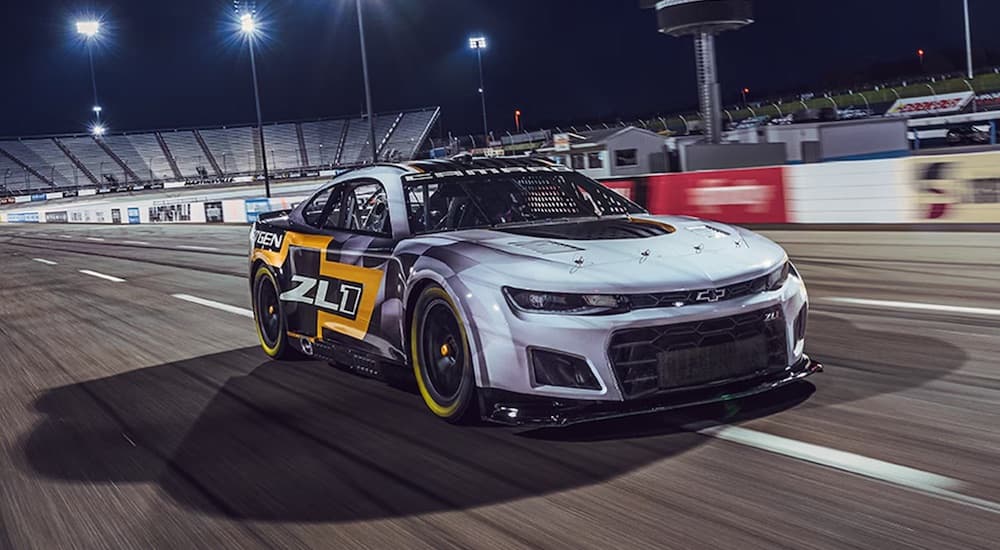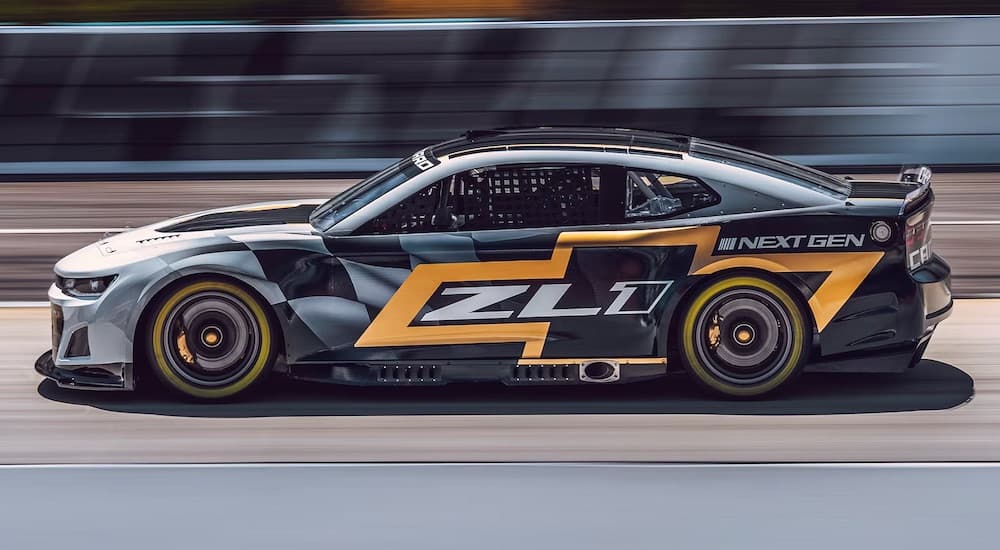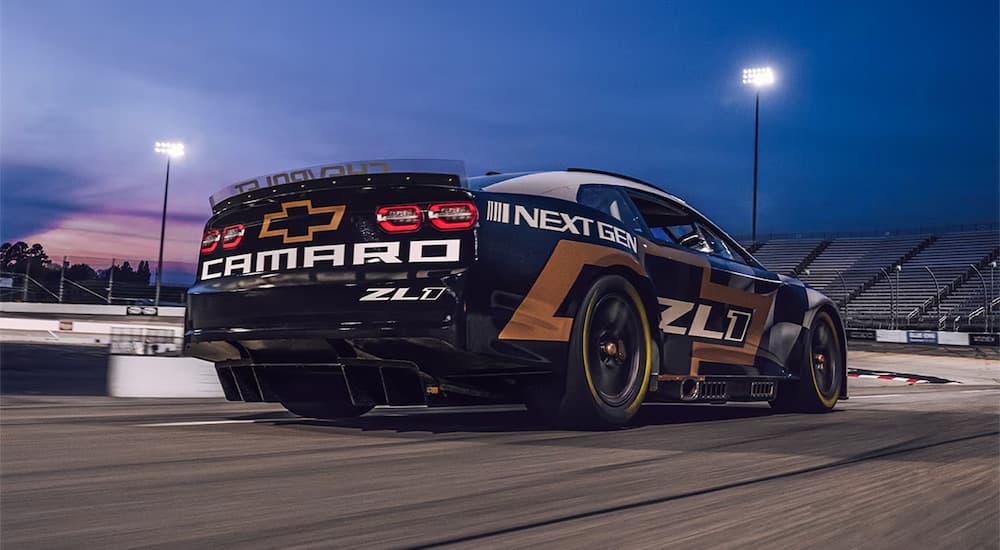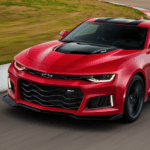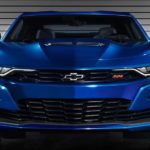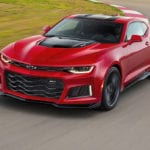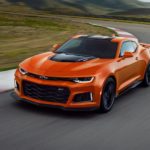There’s no denying Chevy’s impact on the world of NASCAR. The automaker has been a part of the racing series since its earliest days. The brand’s NASCAR roots date as far back as 1955 when Herb Thomas earned Chevy its first podium at the Southern 500 behind the wheel of his Chevrolet 150. Chevy has been building on its impressive trophy case ever since and currently stands as the sport’s winningest brand, with an astounding 851 victories to its name.
In the years since Thomas’ first NASCAR victory, Chevy has never stopped improving on its racing lineup. The company’s NASCAR entrants have included some of the most iconic models in the Chevy lineup, with renowned drivers like Jeff Gordon, Jimmy Johnson, Dale Earnhardt, and Tony Stewart cruising to victory in race-ready versions of the Bel Air, Biscayne, Chevelle Laguna, Lumina, Monte Carlo and Impala, to name a few. Some of these were the exact same Chevy models you could have found at your local Chevy dealer, while others were high-performance versions inspired by their production-level counterparts. These brawny Chevy cars have powered the automaker to a total of 42 Manufacturers’ Championships, including an incredible 13 straight titles from 2003 to 2015.
Since 2013, the Camaro has been Chevy’s go-to for achieving on-track dominance. The fabled model—which many consider to be the first and last name in American muscle—has lent its name to several NASCAR models over the last decade, starting with the fifth-generation Camaro in 2013. The high-performance Camaro ZL1 entered the fray in 2018, followed by the sixth-generation Camaro ZL1 1LE in 2020. The Camaro has been one of the company’s most successful models in NASCAR, largely thanks to driver Jimmie Johnson, who raced various Camaro models to a cup title in 2013 and 2016. Chase Elliot (2020) and Kyle Larson (2021) have been the latest drivers to take the Camaro to victory lane in racing’s premier series, cementing the muscle car’s reputation as a perennial frontrunner.
That said, the Camaro’s legendary run could soon be coming to an end as the sixth-gen model will be retired at the end of the 2024 model year. With no immediate plans for a replacement, this leaves Chevy’s racing future up in the air, so what model should we expect to see rounding the corners in the NASCAR Cup Series beyond 2024?
Creating a Dynasty
Chevy’s reign as NASCAR’s ruling party started in 1979 when Richard Petty drove his Chevy Monte Carlo to victory. While Petty earned most of his NASCAR wins in Plymouth and Dodge models, The King made a late-career switch to Chevy, allowing him to notch his seventh and final cup series championship under the bowtie brand.
A Monte Carlo Aerocoupe—designed with a shorter trunk lid and sloped rear window than the standard Monte Carlo—was the weapon of choice for Dale Earnhardt in the 1987 NASCAR season. The aerodynamic racer won Earnhardt a career-high 11 races, not to mention his third championship. Chevy would replace the Monte Carlo with the Lumina in 1989, but it didn’t slow down Earnhardt, who would win his fourth championship in the new model. The Lumina also got a chance to make its own star turn in 1990 when it starred alongside Tom Cruise in the Hollywood hit “Days of Thunder.”
Jeff Gordon would be the next driver to dominate the track in a Chevy, winning four championships between 1995 and 2001 in a Monte Carlo model, followed by an equally impressive run from Jimmie Johnson that saw him take home the cup every year between 2006 and 2010. Things started to change in 2007 as NASCAR introduced the new Car of Tomorrow (CoT) standards for participating vehicles. Built with a focus on safety, these models included a front splitter and rear wing, which replaced the spoiler used in previous models. Chevy ran both Monte Carlo- and SS-based CoT models between 2008 and 2012, with Johnson and Tony Stewart continuing to rack up championships.\
Enter the Camaro
Introduced in 2013, the next wave of NASCAR models became known as the Gen 6 car. Built with carbon fiber parts and digital dashboards, the Gen6 models included one significant change from the outgoing CoT models: instead of sticking to a standardized shape, Gen 6 models were designed to reflect the dimensions of their production-level counterparts. Gen 6 is also where the Camaro ZL1 entered the picture, with the fifth-generation model bringing Johnson considerable success in the early 2010s. The Camaro ZL1 was a marked improvement over the SS, weighing 100 lbs less and improving its zero-to-60-mph time by 0.2 seconds. A 750 hp, four-speed manual transmission and steel and carbon body gave the Camaro ZL1 a considerable leg up on the track, earning Chevy no shortage of impressive finishes in its day.
That brings us to NASCAR’s current Next Gen era, which officially kicked off in 2021. With this move came the transition from the Camaro ZL1 to the Camaro ZL1 1LE, which earned considerable attention right out of the gate as Kyle Larson took home the cup in his No. 5 Camaro ZL1 1LE. An homage to the third-generation 1LE Camaro model that carved out a reputation as a serious motorsports contender in the late ‘80s, the Camaro ZL1 1LE that you can find at Chevy dealers includes all the bells and whistles one would expect from a modern performance racer. Chevy has outfitted it with lighter wheels and dampers, thinner rear glass to shed 50 lbs from the previous version, and a supercharged, 650 hp LT4 engine.
The NASCAR version of the ZL1 1LE has some major differences from the street car, but is also designed to give Chevy’s drivers all the power they need to compete for the checkered flag. “The ZL1 1LE is the highest performer within the Camaro production-car lineup,” said Jim Campbell, U.S. vice president of Performance and Motorsports. “We took lessons from the production car and applied them to the new 2020 Cup car.”
Designed using some of the industry’s most sophisticated, cutting-edge tools like computational fluid dynamics (CFD), reduced-scale and full-scale wind-tunnel testing, and simulation, the Camaro is about as sophisticated as this sort of car comes, from an engineering perspective. This high-tech approach has led to plenty of success in not just the NASCAR Cup series but in every racing series the Camaro ZL1 1LE competes in, including NHRA Funny Car, Pro Stock and Sportsman classes, Michelin Pilot Challenge GS Class, and the Pirelli World Challenge GTS division.
The Road Ahead
To compete in NASCAR, vehicles must be based on existing production models, so with the sixth-generation Camaro set to hit the old dusty trail after 2024, what does the future hold for Chevy’s NASCAR ambitions? In the short term, it doesn’t look like there will be any significant changes. “We plan to continue to compete and win at the highest levels of auto racing,” says Campbell. “Camaro will continue to compete on track, working with motorsports sanctioning bodies to ensure Chevrolet’s presence in racing moving forward.”
According to NASCAR, the Camaro is essentially grandfathered into the racing series thanks to the fact that the car was a production vehicle during the original submission window for the Next Gen era. That means that Chevy can keep running the Camaro ZL1 1LE for the foreseeable future, but what does the future hold for the average driver when it comes to the Camaro? Again, it’s hard to tell, but the answer might be blowing in the wind.
There’s no denying the impact of electric vehicles (EV) on today’s auto market, with even some of the industry’s most famous nameplates—like the Ford Mustang, F-150, and Chevy Silverado—all getting their own all-electric models. The smart money would say that the Camaro will eventually return in EV form, with rumors of an all-electric four-door model in the works for 2025. While this move might annoy some internal combustion-loving purists, it could also bring a host of performance-related benefits. In addition to their low cost of ownership and environmentally friendly bona fides, EVs also offer the sort of instant acceleration that makes for such much success at the track. An electrified Camaro would slot in well amongst other sporty EV options like the Audi RS E-Tron GT, Kia EV6 GT, and Tesla Model S Plaid.
This migration towards an all-electric future isn’t limited to public roads. While NASCAR has yet to announce a series specific to hybrid or EV models, it’s built such contingencies into its plans. The Next Gen car, for example, was designed with hybrid and EV powertrains in mind, which would make expanding into some alternative-fuel events an easy transition. The Fédération Internationale de l’Automobile (FIA) has already made a similar move with the debut of Formula E in 2014, giving fans an all-electric alternative to the Formula 1 series. In fact, even Formula 1 cars have relied on hybrid powertrains since 2014, with the precedent making it easy to imagine a hybrid or EV NASCAR series.
At a cost of around $400,000, the Camaro’s NASCAR iteration is well outside the budget of the average driver. That said, Chevy is making it easier than ever to get your hands on a Camaro model that certainly wouldn’t look out of place rounding the corner at Talladega or Circuit de la Sarthe. Designed to commemorate the modified NASCAR-grade Camaro competing in the 2023 24 Hours of Le Mans at the famous French circuit, the 2024 Chevy Camaro ZL1 Garage 56 Edition is about as close as most of us are ever going to get to living out our NASCAR dreams.
Limited to just 56 models and styled with graphics inspired by those found on the race-ready version, the Camaro ZL1 Garage 56 Edition features a supercharged 6.2L V8, making 650 hp. The racy model also includes a few features from the Camaro’s track-focused 1LE trim, including elements designed to improve the muscle car’s aerodynamics, such as dive planes, a front splitter, and a wicker bill rear spoiler. Painted in Riptide Blue and outfitted with a thin gold stripe, NASCAR 75th Anniversary badge, Hendrick Motorsports logo, and blacked-out American flag graphic across the hood, the Chevy Camaro ZL1 Garage 56 Edition can also be optioned with additional NASCAR, Goodyear, and number 24 decals.
Chevy and the Camaro Aren’t Leaving NASCAR
From Richard Petty’s STP-branded number 43 to Jeff Gordon’s number 24 and Dale Earnhardt’s blacked-out 3, Chevy has long been the brand that’s propelled some of NASCAR’s biggest stars to a spot in the limelight. Jimmie Johnson dominated the sport throughout much of the last two decades behind the wheel of SS, Impala, and Camaro, proving that Chevy’s on-track success is anything but a fluke. World-class racing series like NASCAR have long been a testing ground for drivers and automakers alike, and Chevy seems to have found the winning formula when it comes to designing a winning racer and scouting drivers. The Camaro ZL1 1LE is the most recent model to propel the brand to the top of the NASCAR podium, but it sure won’t be the last. The Camaro doesn’t look like it’s going anywhere for the time being, but when it does take its final victory lap, something tells us that its replacement will be more than up to the task of carrying on the Chevy racing legacy.
